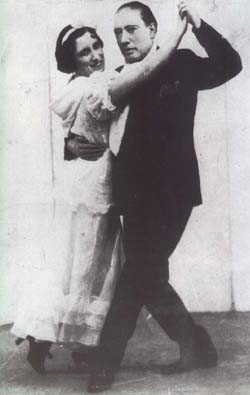
The exact origins of tango—both the dance and the word itself—are lost in myth and an unrecorded history. The generally accepted theory is that in the mid-1800s, the African slaves who had been brought to Argentina or their descendants began to influence the local culture. The word “tango” may be straightforwardly African in origin, meaning “closed place” or “reserved ground.” Or it may derive from Portuguese (and from the Latin verb tanguere, to touch) and was picked up by Africans on the slave ships. Whatever its origin, the word “tango” had acquired the standard meaning of the place where African slaves and free blacks gathered to dance by the time Argentina banned slavery in 1853.
During the later part of the 1800s and early 1900s, Argentina was undergoing a massive immigration. In 1869, Buenos Aires had a population of 180,000. By 1914, its population was 1.5 million. The intermixing of African, Spanish, Italian, British, Polish, Russian and native-born Argentines resulted in a melting pot of cultures, and each borrowed dance and music from one another. Traditional polkas, waltzes and mazurkas were mixed with the popular habanera from Cuba and the candombe rhythms from Africa.
Most immigrants were single men hoping to earn their fortunes in this newly expanding country. They were typically poor and desperate, hoping to make enough money to return to Europe or bring their families to Argentina. The evolution of tango reflects their profound sense of loss and longing for the people and places they left behind.
Most likely, rudimentary dance forms that may have been known as “tango” were developed in African-Argentine dance venues. These venues were frequented by compadritos, young men—mostly native born, poor and of mixed ancestry—who liked to dress in slouch hats, loosely tied neckerchiefs and high-heeled boots with knives tucked casually into their belts. The compadritos took the dance to the Corrales Viejos—the slaughterhouse district of Buenos Aires—and introduced it in various low-life establishments where dancing took place: bars, dance halls and brothels. It was in these tenements where the African rhythms met the Argentine milonga music (a fast-paced polka). Soon new steps were invented and took hold as a new form of dance that combined traditions from many cultures. Exactly when and where the various forms of dance and music combined to create what became widely understood as tango is unclear. What is clear was that tango was considered a dance from the poor barrios.
Although high society looked down upon the activities in the barrios, well-heeled sons of the porteño oligarchy were not averse to slumming. Eventually, everyone found out about the tango and, by the beginning of the twentieth century, the tango as both a dance and as an embryonic form of popular music had established a firm foothold in the fast-expanding city of its birth. It soon spread to provincial towns of Argentina and across the River Plate to Montevideo, the capital of Uruguay, where it became as much a part of the urban culture as in Buenos Aires.
The worldwide spread of the tango came in the early 1900s when wealthy sons of Argentine society families made their way to Paris and introduced the tango into a society eager for innovation and not entirely averse to the risqué nature of the dance or dancing with young, wealthy Latin men. By 1913, the tango had become an international phenomenon in Paris, London and New York. There were tango teas, tango train excursions and even tango colors—most notably orange. The Argentine elite who had shunned the tango were now forced into accepting it with national pride.
The tango spread worldwide throughout the 1920s and 1930s. The dance appeared in movies and tango singers traveled the world. By the 1930s, the Golden Age of Argentina was beginning. The country became one of the ten richest nations in the world and music, poetry and culture flourished. The tango came to be a fundamental expression of Argentine culture, and the Golden Age lasted through the 1940s and 1950s.
Tango’s fortunes have always been tied to economic conditions and this was very true in the 1950s. During this time, as political repression developed, lyrics reflected political feelings until they started to be banned as subversive. The dance and its music went underground as large dance venues were closed and large gatherings in general were prohibited. The tango survived in smaller, unpublicized venues and in the hearts of the people.
The necessity of going underground combined with the eventual invasion of rock and roll sent the tango into decline until the mid-1980s when the stage show Tango Argentino opened in Paris. Once again Paris was ground zero for igniting tango excitement worldwide. The show toured the world and stimulated a revival in Europe, North America and Japan that we are part of today.